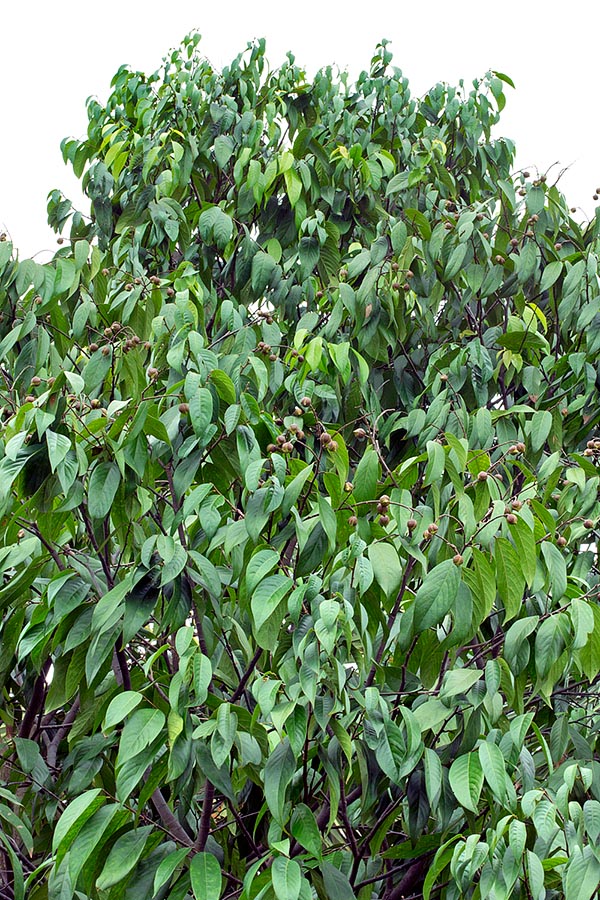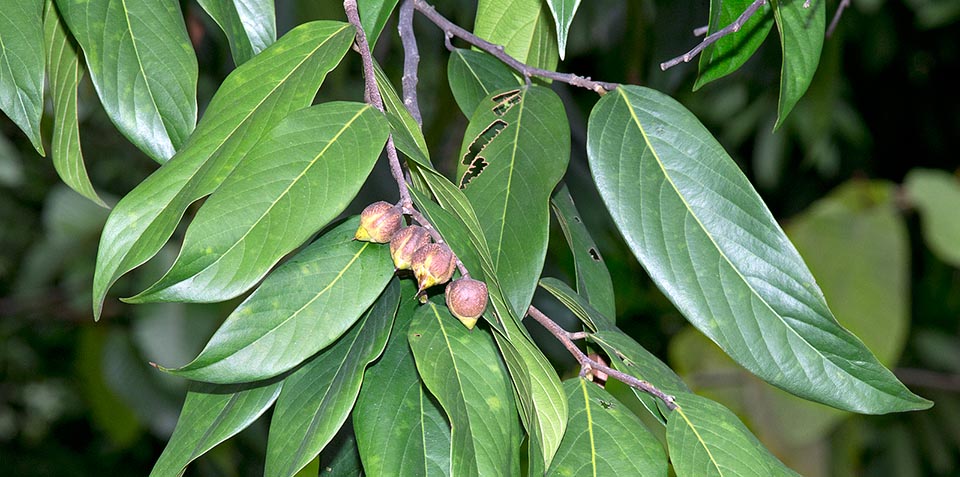Family : Dipterocarpaceae

Text © Pietro Puccio

English translation by Mario Beltramini

Neobalanocarpus heimii is a Peninsular Malaysia, Singapore and Thailand tree that may be 60 m tall. A almost colourless resin used for prized paints gets out from the bark’s wounds © Giuseppe Mazza
The species is native to Peninsular Malaysia, Singapore and Thailand where it grows in the rainforests from the sea level up to about 1000 m of altitude.
The generic name is formed by the Greek prefix “νέο-” (neo-) = new and Balanocarpus, genus previously established, in its turn composed by the Greek substantives “βάλανος” (balanos) = acorn and “καρπός” (carpos) = fruit, with obvious reference; the species is honoured to the botanist Frédéric Louis Heim (1869-?).
Common names: chengal (English); cengal, chengal, penak (Malaysia); takhian-chan, takhian-chantamaeo, chi-ngamat (Thailand).
The Neobalanocarpus heimii (King) P.S. Ashton (1982) is an evergreen tree that may reach a height of 60 m in the old specimens in nature, with erect trunk, up to more than 1 m of diameter, with brown-dark longitudinally fissured bark tending to flake and tabular roots at the base (flat roots similar to buttresses that contribute to the support of big trees).
The leaves, on a 0,5-1 cm long petiole, are simple, alternate, oblong-lanceolate with long pointed apex and entire margin, 8-15 cm long and 2-5 cm broad, coriaceous, of glossy intense green colour. Axillar or terminal panicle inflorescences, about 10 cm long, bearing hermaphroditic flowers with 5 ovate sepals, corolla with 5 elliptic petals of yellowish green colour and 15 stamina; the flowers, fragrant, are mainly pollinated by the bees.
Dry indehiscent fruit not winged shaped like an acorn, 4-5 cm long and 2-2,5 cm of diameter, enclosed at the base by the persistent sepals, with glossy woody pericarp of brown colour when ripe, containing only one green seed.
It reproduces by seed, that must be interred in the shortest possible time, in draining loam rich of organic substance maintained humid and shaded at the temperature of 24-26 °C, with germination times of 4-9 days and first blooming starting from the tenth year of age.
Relatively slow growing tree typical of the tropical rainforests where it grows on various types of soil, provided perfectly draining; requires an exposition in full sun, but during the juvenile phase when it is sensitive to the excessive insolation. Known and appreciated due to the wood of excellent quality, heavy, hard, resistant, elastic, easy to work and long-lasting, resistant to the xylophagous insects and to the fungal attacks, extensively utilized in the past by the local populations for heavy carpentry, civil and naval constructions, bridges, floors, stairs, prized furniture and artistic objects.

As the scientific name says, the fruits remind the acorns. The slow growth and the prized wood have led this plant to the vulnerable specie “Red list” © Giuseppe Mazza
Due to the excessive exploitation it is now almost extinct in some areas and the authorities of Malaysia have forbidden its export and have regulated the cutting. The International Union for Conservation of Nature (IUCN) has inserted this tree in the red list as “vulnerable” (species at risk of extinction in the wild).
From the wounds of the bark exudes a resin almost colourless used in a limited quantity for producing quality varnishes.
Synonyms: Balanocarpus heimii King (1893).
→ To appreciate the biodiversity within the DIPTEROCARPACEAE family please click here.
